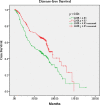Prognostic Value of Pretreatment Lymphocyte-to-Monocyte Ratio and Development of a Nomogram in Breast Cancer Patients
- PMID: 34976782
- PMCID: PMC8719671
- DOI: 10.3389/fonc.2021.650980
Prognostic Value of Pretreatment Lymphocyte-to-Monocyte Ratio and Development of a Nomogram in Breast Cancer Patients
Abstract
Purpose: The objective of this study was to explore the prognostic significance of pretreatment hematologic parameters in predicting disease-free survival (DFS) of breast cancer patients.
Materials and methods: The medical records of 440 breast cancer patients in Shandong Cancer Hospital and Institute from 2003 to 2013 were analyzed retrospectively. Through the results of blood routine before treatment, the absolute lymphocyte count (ALC), absolute neutrophil count (ANC), absolute monocyte count (AMC), and absolute platelet count (APC) in peripheral blood were collected. The lymphocyte-to-monocyte ratio (LMR), neutrophil-to-lymphocyte ratio (NLR), platelet-to-lymphocyte ratio (PLR), and neutrophil-to-monocyte ratio (NMR) were calculated. Cox proportional hazard model was used for univariate and multivariate analysis. The DFS was compared using Kaplan-Meier method. The prognostic nomogram of patients with breast cancer was developed.
Results: The median DFS for all patients was 64.10 months. Univariate analysis showed that the DFS was associated with surgical approach, TNM stage, molecular subtype, neoadjuvant chemotherapy, radiotherapy, and LMR (p < 0.05). TNM stage, molecular subtype, and LMR were independent prognostic factors of breast cancer in multivariate analysis (p < 0.05). According to the Kaplan-Meier survival curve analysis, patients with higher LMR (≥4.85) were associated with longer median DFS (median DFS, 85.83 vs. 60.90, p < 0.001). The proposed nomogram that incorporated LMR, TNM stage, and molecular subtype got a concordance index (c-index) of 0.69 in predicting 5-year DFS.
Conclusion: In breast cancer patients, higher LMR was associated with longer median DFS and the nomogram including LMR, TNM stage, and molecular subtype could accurately predict the prolonged 5-year DFS of breast cancer patients.
Keywords: breast cancer; disease-free survival (DFS); hematologic parameters; lymphocyte-to-monocyte ratio (LMR); nomogram.
Copyright © 2021 Yin, Zhang, Li, Zhang, Liu and Yuan.
Conflict of interest statement
The authors declare that the research was conducted in the absence of any commercial or financial relationships that could be construed as a potential conflict of interest.
Figures


Similar articles
-
The Peripheral Blood Neutrophil-To-Lymphocyte Ratio Is Superior to the Lymphocyte-To-Monocyte Ratio for Predicting the Long-Term Survival of Triple-Negative Breast Cancer Patients.PLoS One. 2015 Nov 18;10(11):e0143061. doi: 10.1371/journal.pone.0143061. eCollection 2015. PLoS One. 2015. PMID: 26580962 Free PMC article.
-
Prognostic value of pre-operative inflammatory response biomarkers in gastric cancer patients and the construction of a predictive model.J Transl Med. 2015 Feb 18;13:66. doi: 10.1186/s12967-015-0409-0. J Transl Med. 2015. PMID: 25885254 Free PMC article.
-
Pretreatment neutrophil/lymphocyte, platelet/lymphocyte, lymphocyte/monocyte, and neutrophil/monocyte ratios and outcome in elderly breast cancer patients.Clin Transl Oncol. 2019 Jul;21(7):855-863. doi: 10.1007/s12094-018-1999-9. Epub 2018 Nov 30. Clin Transl Oncol. 2019. PMID: 30506134
-
Prognostic value of systemic inflammatory markers and development of a nomogram in breast cancer.PLoS One. 2018 Jul 26;13(7):e0200936. doi: 10.1371/journal.pone.0200936. eCollection 2018. PLoS One. 2018. PMID: 30048474 Free PMC article.
-
Prognostic and predictive value of neutrophil-to-lymphocyte ratio after curative rectal cancer resection: A systematic review and meta-analysis.Surg Oncol. 2021 Jun;37:101556. doi: 10.1016/j.suronc.2021.101556. Epub 2021 Mar 31. Surg Oncol. 2021. PMID: 33819850
Cited by
-
High peripheral neutrophil and monocyte count distinguishes renal cell carcinoma from renal angiomyolipoma and predicts poor prognosis of renal cell carcinoma.Heliyon. 2024 Jun 4;10(11):e32360. doi: 10.1016/j.heliyon.2024.e32360. eCollection 2024 Jun 15. Heliyon. 2024. PMID: 38961913 Free PMC article.
-
Monocyte-to-lymphocyte ratio is a prognostic predictor for patients with non-small cell lung cancer treated with stereotactic body radiation therapy.Rep Pract Oncol Radiother. 2024 Jun 6;29(2):228-235. doi: 10.5603/rpor.100168. eCollection 2024. Rep Pract Oncol Radiother. 2024. PMID: 39143976 Free PMC article.
-
Prognostic Parameters of Palbociclib in HR+/HER2- Advanced Breast Cancer: A Narrative Review.Technol Cancer Res Treat. 2023 Jan-Dec;22:15330338231173504. doi: 10.1177/15330338231173504. Technol Cancer Res Treat. 2023. PMID: 37186799 Free PMC article. Review.
-
Clinical characteristics and prognostic factors of male breast cancer in China.Front Oncol. 2024 Mar 8;14:1362826. doi: 10.3389/fonc.2024.1362826. eCollection 2024. Front Oncol. 2024. PMID: 38525418 Free PMC article.
-
Predictive model using systemic inflammation markers to assess neoadjuvant chemotherapy efficacy in breast cancer.Front Oncol. 2025 Mar 24;15:1552802. doi: 10.3389/fonc.2025.1552802. eCollection 2025. Front Oncol. 2025. PMID: 40196740 Free PMC article.
References
-
- Jia W, Wu J, Jia H, Yang Y, Zhang X, Chen K, et al. . The Peripheral Blood Neutrophil-to-Lymphocyte Ratio Is Superior to the Lymphocyte-to-Monocyte Ratio for Predicting the Long-Term Survival of Triple-Negative Breast Cancer Patients. PloS One (2015) 10(11):e0143061. doi: 10.1371/journal.pone.0143061 - DOI - PMC - PubMed
LinkOut - more resources
Full Text Sources

